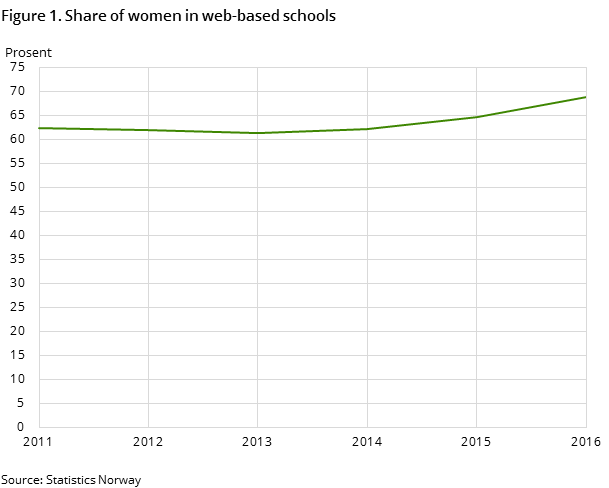Content
Published:
This is an archived release.
Higher share of women on web-based courses
In the autumn of 2016, there were slightly less than 12 000 participants in web-based schools. The share of women participating in web-based courses has been increasing slightly over the past years, and in 2016, the share of female participants in web-based education was 69 per cent.
| 2015-2016 | |||
|---|---|---|---|
| Completed educations | |||
| Total | Males | Females | |
| Special field, total | 9 686 | 38 | 62 |
| General programmes | 1 447 | 36 | 64 |
| Humanities and arts | 1 033 | 36 | 64 |
| Education | 628 | 9 | 91 |
| Social sciences and law | 548 | 34 | 66 |
| Business and administration | 2 655 | 27 | 73 |
| Natural sciences, vocational and technical subjects | 601 | 60 | 40 |
| Health, welfare and sport | 1 292 | 16 | 84 |
| Primary industries | - | . | . |
| Transport and communications, safety and security and other services | 1 220 | 92 | 8 |
| Unspecified field of study | 262 | 46 | 54 |

Between 2011 and 2014, the share of women participating in web-based courses was stable at 62 per cent, while increasing to 64 and 69 per cent in 2015 and 2016 respectively. All of the Norwegian counties have a majority of female participants, but the share of women participating in web-based courses differs. The counties of Sogn og Fjordane and Aust-Agder have the highest shares of women on web-based courses, with 75 and 74 per cent respectively. Gender disparities are smallest in the counties of Sør-Trøndelag and Oslo, where women represent 66 and 62 per cent of the participants.1
Forty per cent of the participants in web-based schools are in the age group 20 to 30 years, while only 10 per cent are over the age of 50. There are no gender disparities in the age distribution of the participants.
During the academic year 2015/16, there were around 9 700 course completions. There was also an overrepresentation of women who completed courses in this year, with 62 per cent. Women represent a majority within all fields of education, except for the fields of «transport and communications, safety and security and other services» and «natural sciences, vocational and technical subjects». In these fields, 92 and 60 per cent of the courses are completed by male participants. In the field of education, on the other hand, the share of female participants is 91 per cent, whereas women represent 84 per cent of the completions in the field of «health, welfare and sport».
1 Correction in the text.
Missing data for IndustriskolenOpen and readClose
Data for 2016 are missing for the web-based school Industriskolen. This school had around 800 participants in 2015, the majority of whom were men. Taking this into consideration, there is nevertheless an increase in the share of women in web-based courses from 2015 to 2016.
This page has been discontinued, see .
Contact
-
Statistics Norway's Information Centre
E-mail: informasjon@ssb.no
tel.: (+47) 21 09 46 42
